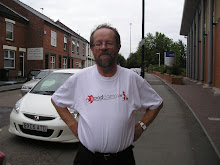Yesterday we got to Sacreda Familia (Holy Family) rather late, so didn’t go in. It’s Barcelona’s Cathedral, and is still being finished - after more than a hundred years! This isn’t for want of trying - there may have been some patches of inactivity since it was begun in the 1880s, such as during the Spanish Civil War (when the Cathedral was damaged) but in general it’s been on the go since day one.
It was the dream of a Barcelona bookseller, but I don’t suppose he ever dreamt he’d get what is now in existence. The first architect got as far as building the crypt area, which is substantial in itself, and now houses a museum to the second architect, Gaudi, who between other projects made it his life’s work to design the most remarkable cathedral in Christendom. He sometimes lived in the Cathedral; he had his workshop there at times, and he’s buried there. He’s so honoured that I’m sure most Barcelonians know his name. And he deserves all the honour heaped on him. Somehow he managed to create a monument to God, to Christ (and Mary) and to creation that is so strange and so remarkable that at first you just don’t know what to make of it.
Our first view of it, from across the street, made us wonder what the heck the place actually was. Because it’s still being built, there are cranes everywhere, and scaffolding. Several of the twenty odd towers that will eventually exist are there, and some of them have been there for more than a century. But your first impression of the building is of towers that are full of strange holes, and of a surface that’s so decorated you can’t grasp anything.
Fortunately, when you get up close you realise what’s going on. The way the surface seems to be sliding off itself, like icing melting on a cake, isn’t the case at all: the surface is covered with natural things such as plants and animals. Sculptured vines and creepers cover the building; there are dozens of sculptures of animals and people: stories from the Bible, and liturgical symbols. Each spire has a different top, and nothing is repeated anywhere. At present the tallest tower is 120 metres; in due course the one that focuses on Christ will be 170 metres, making the Cathedral not only the tallest building in Barcelona, but also the tallest church in the world.
Gaudi said: to be original go back to the Origin. And he has done. He continually studied plants and animals to see how things were structured, and used the designs in his buildings. (Not just the Cathedral but also all of his other architectural pursuits.) This created enormous problems for his sculptors, his engineers, his stonemasons, and everyone else connected with the building. But so loyal were they to Gaudi, and to his vision, that they overcome the problems again and again. Gaudi himself made intricate models of the most difficult parts of the structure, and many of these are on display in the museum in the crypt. Unfortunately most of his drawings and plans were destroyed in the Civil War, but subsequent architects and others have worked hard to discover exactly what he intended and to make sure his intentions are carried out.
The inside of the cathedral is at present full of scaffolding, but some areas are complete. In due course all the windows will have stained glass in them, but for now only two of these are finished, and they are both kaleidoscopes of colour. The inner columns weave up to the ceiling area like great plant stalks. None of them are simply round: they have been built so that they almost spiral upwards. In the ceiling itself, the stone is shaped like flowers and leaves, and these hang out over the columns. The balcony, which is high above the floor, and goes along both sides of the building, will hold 1200 to 1500 singers one day - when the place is complete. It’s shaped in a great wave, weaving in and out. The staircases are spiral, and you can already climb far up to the top of what’s completed - or take a lift. Celia reckoned Health and Safety would have something to say about thousands of tourists coming into a building site - which is what it is. Most of the floor is covered with moulds, and great pieces of stone, and building materials.
Outside what is currently the front entrance, are some of Gaudi’s famous leaning columns. These start out some distance from the wall, and fall back onto it, as it were. And over the doors are sculptures of the fourteen stations of the Cross. They’re not in the usual order - Christ naked on the cross is at the centre - but they wonderfully vivid, and striking.
As you can see, the place made quite an impression on us. And then we got a bus to Parc Guell, which was originally intended to be a place where sixty of Gaudi’s designed houses would be built. In the end only two (and a gatehouse) were finished. It’s now been turned into a park for the public, and has more of his almost outrageous designs scattered about. Perhaps more on those in the next post.
Subscribe to:
Post Comments (Atom)

No comments:
Post a Comment